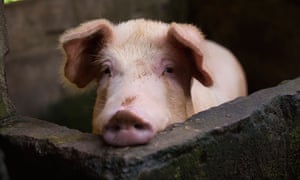A new emerging highly contagious strain of swine flu virus in China is causing global health concerns all over the globe as the world battles with the ongoing COVID19 pandemic, reports the Guardian
The G4 strain has already infected 10% of the industry’s workers in China but no evidence of human to human transmission have been found yet.
A Pandemic Triggering Swine Flu

Researchers in China have discovered a new type of swine flu that is capable of triggering a pandemic, according to a study in the US science journal PNAS, although experts said there is no imminent threat.
Named G4, it is genetically descended from the H1N1 strain that caused a pandemic in 2009.
Virus Highly Adapted To Infect Humans?
It possesses “all the essential hallmarks of being highly adapted to infect humans”, said the authors, scientists at Chinese universities and China’s Center for Disease Control and Prevention, in the study published on Monday.
Between 2011 and 2018, researchers took 30,000 nasal swabs from pigs in slaughterhouses in 10 Chinese provinces and in a veterinary hospital, allowing them to isolate 179 swine flu viruses.
The majority were of a new kind that has been dominant among pigs since 2016.
The researchers then carried out various experiments – including on ferrets, which are widely used in flu studies because they experience similar symptoms to humans.
Tests also showed that any immunity humans gain from exposure to seasonal flu does not provide protection from G4.
- More than one in 10 swine workers in the new study had already been infected, according to antibody blood tests which showed exposure to the virus.
- The tests also showed that as many as 4.4% of the general population also appeared to have been exposed.
No Human Transmission Evidence
The virus has therefore already passed from animals to humans but there is no evidence yet that it can be passed from human to human – the scientists’ main worry.
WHO To Follow the Study
The World Health Organization (WHO) will read the Chinese study carefully, spokesman Christian Lindmeier told a Geneva briefing on Tuesday, saying it was important to collaborate on findings and keep tabs on animal populations.
“It also highlights we cannot let our guard down on influenza and need to be vigilant and continue surveillance even in the coronavirus pandemic,” he added.
Chinese Foreign Ministry spokesman Zhao Lijian told a daily news conference on Tuesday that China was closely following developments. “We will take all necessary measures to prevent the spread and outbreak of any virus,” he said.
Risk of Viruses Crossing Species Barrier
The study highlights the risks of viruses crossing the species barrier into humans, especially in densely populated regions in China, where millions live close to farms, breeding facilities, slaughterhouses and wet markets.
The current coronavirus sweeping the world is believed to have originated in horseshoe bats in southwest China and could have spread to humans via a seafood market in the central city of Wuhan, where the virus was first identified.
“It is of concern that human infection of G4 virus will further human adaptation and increase the risk of a human pandemic,” the researchers wrote.
Call for Urgent Measures To Monitor People
The authors called for urgent measures to monitor people working with pigs.
James Wood, head of the department of veterinary medicine at Cambridge University, said: “The work comes as a salutary reminder that we are constantly at risk of new emergence of zoonotic pathogens and that farmed animals – with which humans have greater contact than with wildlife – may act as the source for important pandemic viruses.”
A zoonotic infection is caused by a pathogen that has jumped from a non-human animal into a human.
Although it is capable of infecting humans, there is no imminent risk of a new pandemic, said Carl Bergstrom, a biologist at the University of Washington.
“There’s no evidence that G4 is circulating in humans, despite five years of extensive exposure,” he said on Twitter. “That’s the key context to keep in mind.”
Did you subscribe to our daily newsletter?
It’s Free! Click here to Subscribe!
Source: The Guardian



















